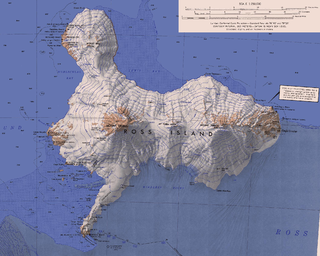
Aheloy Nunatak is a rocky 390m peak in the upper Huron Glacier in Livingston Island. The peak forms the northeast extremity of a minor ridge which also features Erma Knoll and Lozen Nunatak, and is linked to Zograf Peak by Lozen Saddle. The peak was first visited on 31 December 2004 by the Bulgarian Lyubomir Ivanov from Camp Academia, and was mapped in the Bulgarian Tangra 2004/05 topographic survey. The peak was named after the Black Sea town of Aheloy, Bulgaria.

Atanasoff Nunatak is a nunatak, a sharp peak rising to 523 m in the east extremity of Bowles Ridge, Livingston Island, Antarctica. The peak surmounts Huron Glacier to the south and east, and Struma Glacier to the north. The peak is “named in honour of the Bulgarian American John Atanasoff (1903-1995) who constructed the first electronic digital computer”.

Godech Nunatak is a rocky 410m peak in lower Huron Glacier, in the north foothills of Tangra Mountains on Livingston Island, South Shetland Islands in Antarctica. The peak is named after the town of Godech in Western Bulgaria.

Helis Nunatak is a crown-shaped rocky peak of elevation 340 m in Vidin Heights on Varna Peninsula, Livingston Island in the South Shetland Islands, Western Antarctica. The peak is named after the ancient Thracian capital town of Helis whose remains are located at Sveshtari, northeastern Bulgaria.

Kaloyan Nunatak is a conspicuous nunatak in the Tangra Mountains. It is named after Czar Kaloyan of Bulgaria, 1197-1207 AD.

The Kukeri Nunataks are two rocky peaks with an elevation of 320 metres (1,050 ft), on Huron Glacier, Livingston Island, off West Antarctica. The Kukeri Nunataks are situated in the north foothills of the Tangra Mountains, 200 metre away from each other.

Lozen Nunatak is a 440m hill in upper Huron Glacier, Livingston Island. It is part of a minor ridge in the north foothills of Tangra Mountains including also Erma Knoll and Aheloy Nunatak, and linked to Zograf Peak by Lozen Saddle. The hill was first visited on 17 December 2004 by the Bulgarian Lyubomir Ivanov from Camp Academia. It is named after the Lozen Monastery of St. Spas in western Bulgaria.

Lozen Saddle is a 437 m high saddle situated between Lozen Nunatak and Zograf Peak in Tangra Mountains, eastern Livingston Island in the South Shetland Islands, Antarctica which provides overland access from the Wörner Gap area to the Shipka Valley. The saddle was first crossed by the Bulgarian Lyubomir Ivanov from Camp Academia on 17 December 2004, and takes its name from the adjacent Lozen Nunatak.

Maritsa Peak rises to 560 m in eastern Bowles Ridge on Livingston Island in the South Shetland Islands, Antarctica. It has precipitous rocky south slopes, and is situated on the west side of Pirdop Gate, surmounting Huron Glacier to the south and Struma Glacier to the north. The peak is "named after the Maritsa River in Bulgaria."

Nestinari Nunataks are a pair of rocky peaks of elevation 470 m and 520 m in middle Huron Glacier, Livingston Island in the South Shetland Islands, Antarctica. Situated in the north foothills of Tangra Mountains, 210 m away from each other.

Panagyurishte Nunatak is a rocky peak of elevation 150 m projecting from Yakoruda Glacier, Greenwich Island in the South Shetland Islands, Antarctica. The peak is named after the town of Panagyurishte in central Bulgaria.

Rakovski Nunatak is a rocky peak of elevation 430 m in Vidin Heights on Varna Peninsula, Livingston Island in the South Shetland Islands, Antarctica. Surmounting Rose Valley Glacier to the north.

Ravda Peak is a rocky peak of elevation 664 m in Levski Ridge, Tangra Mountains, Livingston Island in the South Shetland Islands, Antarctica. Situated on the side ridge projecting northwards from Levski Peak into Huron Glacier. The peak was first ascended by the Bulgarian Lyubomir Ivanov from Camp Academia on 21 December 2004.

Tran Crag rises to 490 m in the Tangra Mountains of Livingston Island in the South Shetland Islands, Antarctica and projects from the tributary glacier draining the west slopes of Friesland Ridge between St. Boris Peak and Simeon Peak. It is named after the town of Tran in Western Bulgaria.

Willan Saddle is a flat, crescent-shaped and ice-covered saddle extending 1 km in the northeast-southwest direction between Burdick South Peak and Willan Nunatak in eastern Livingston Island in the South Shetland Islands, Antarctica. The saddle has an elevation of 400 m and is part of the overland route between Balkan Snowfield and Charrúa Gap in the west and Orpheus Gate in the east, thus providing access from the Bulgarian Base and the Spanish Base to the interior of eastern Livingston Island.

Zlatograd Rock is a rocky 240 m peak forming the eastern extremity of Bowles Ridge, Livingston Island in the South Shetland Islands, Antarctica. The peak overlooks Struma Glacier to the northwest and Huron Glacier to the southeast. It is named after the town of Zlatograd in the Rhodope Mountains, Southern Bulgaria.

Willan Nunatak is an ice-free tipped peak rising to 449 m on the glacial divide between Huntress Glacier and Balkan Snowfield on Hurd Peninsula in eastern Livingston Island in the South Shetland Islands, Antarctica. It is linked to Burdick South Peak to the northeast by Willan Saddle and, via Castillo Nunatak and Charrúa Gap, to Charrúa Ridge to the west.

Castillo Nunatak is a conspicuous rocky peak rising to 437 m on the glacial divide between Huntress Glacier and Balkan Snowfield on Hurd Peninsula in eastern Livingston Island in the South Shetland Islands, Antarctica. It is linked to Charrúa Ridge to the west Charrúa Gap and, via Willan Nunatak and Willan Saddle, to Burdick Ridge to the east-northeast. Castillo Nunatak is a prominent landmark in the Charrúa Gap area.















